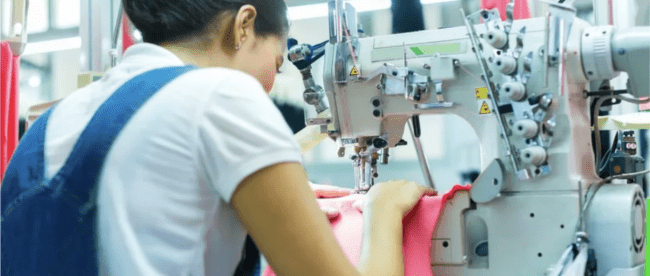The FABRIC Act: Mending Workplace Protections in American Garment Manufacturing

(Source)
The global fashion industry produces more than 100 to 150 billion items of clothing per year. 400% more clothes are produced compared to 20 years ago. Today, fashion accounts for up to 10% of global carbon dioxide output and a fifth of the 300 million tons of plastic produced globally each year. In the United States alone, landfills receive 11.3 million tons of textiles and the nation throws away the equivalent of around 70 pairs of pants per person in clothing and footwear waste each year. If current practices continue, the United Nations Environment Programme believes that the fashion industry will use up a quarter of the world’s carbon budget by 2050.
Some fashion brands and retailers are releasing sustainability reports and setting goals to use more recycled or organic materials. Zara, for example, made a commitment that 50% of items sold in 2022 would be manufactured according to its “Join Life” standards, which include using environmentally friendly raw materials. The new focus on sustainability is a step in the right direction, but production of fossil fuel-based clothing is still projected to grow in the next two decades. It may take more effort from more actors to help curb the adverse effects the fashion industry has on the climate.
Beyond issues in sustainability, the fashion industry faces yet another issue: the unfortunate reality of oftentimes exploitative and dangerous conditions for garment manufacturers. Worldwide, factory owners and managers often fire pregnant workers or deny maternity leave; force workers to do overtime work or risk losing their job; and turn a blind eye when male managers or workers sexually harass female workers. It is also worthy to note that most garment workers around the world are women and 80% are women of color. In 2021, the U.S. took the initiative to show that it was ready to work to end forced labor when President Biden signed the Uyghur Forced Labor Prevention Act (UFLPA) into law. UFLPA’s provisions prohibited imports made by forced labor into the United States from Xinjiang, cementing the nation’s commitment to condemning forced labor and other human rights abuses.
Workers across the globe and in the U.S. face exploitation and wage theft. The U.S. garment sector is a $9 billion industry that employs 95,000 people. Some garment workers in the United States earn as little as $2.68 an hour, over $4 below the current federal minimum wage. Under the piece-rate system, workers are paid per garment sewn; one California garment worker was paid only 3 cents per garment. In 2016, the U.S. Department of Labor investigated 77 Los Angeles garment factories and found that some workers were paid an average of $7 an hour for 10-hour workdays sewing clothes. Additionally, the Department of Labor discovered labor violations at 85% of the factories visited.
In 2021, California became the first state to require hourly wages for garment workers when it passed the Garment Worker Protection Act. This act addressed proper payment of employees in the garment industry by prohibiting payment through the piece-rate system, penalizing manufacturers and brands for wage theft and illegal pay practices. The Garment Worker Protection Act benefited workers, but fashion brands also praised the act, acknowledging that not only would it help level the playing field by addressing and outlawing sweatshop conditions, but it allowed designers to take responsibility for their workers’ working conditions.
Both California’s Garment Worker Protection Act and UFLPA were two important steps in the right direction to ameliorate unfair garment manufacturing conditions. Following in the footsteps of those two pieces of legislation, Senator Kirsten Gillibrand announced the introduction of the Fashioning Accountability and Building Real Institutional Change (FABRIC) Act, the first federal fashion bill, in May 2022. The FABRIC Act would amend the Fair Labor Standards Act of 1938 and aims to protect American garment workers and help revitalize the garment industry in the United States. In terms of protecting garment workers, the FABRIC Act seeks to enforce minimum wage standards and eliminate wage theft in U.S. garment factories.
The FABRIC Act also aims to increase accountability on brands and retailers to combat workplace violations and to increase transparency. Regarding revitalizing the garment industry in the nation, the bill prioritizes incentivizing reshoring with tax credits to support the U.S. garment manufacturing sector and introduces the potential of a $40 million domestic garment manufacturing grant program specifically aimed at revitalizing the industry.
Alongside providing solutions to wage theft and worker exploitation issues, the FABRIC Act provides for a domestic garment manufacturing support program to supply grants to manufacturers for equipment costs, safety improvements, and training and workforce development across the nation to incentivize domestic manufacturing. The United States experienced peak employment in garment manufacturing in 1973, before offshoring and outsourcing overtook the nation’s garment manufacturing sector. The FABRIC Act places emphasis on supporting American garment manufacturers through its $40 million grant and a 30% reshoring tax credit for garment manufacturers who move manufacturing operations to the United States.
Notably, the FABRIC Act narrowly targets the nation’s apparel sector, which could potentially act as a catalyst for similar legislation in other countries. Because the verbiage of the bill clearly articulates the type of labor abuses it aims to combat and because it is sector-specific to the fashion industry, the FABRIC Act may prove to be a promising way to solve some important issues that the U.S. fashion industry currently faces. A range of individuals from fashion designers, founders, and CEOs to directors at labor rights organizations have high praise for the FABRIC Act. The fact that key actors in the fashion industry support the bill provide glimpses of hope for a brighter future for garment workers and the fashion industry itself.
Some concerns about the FABRIC Act include the worry that reshoring production could result in job losses in regions where brands currently manufacture, but that may not be the case if the FABRIC Act does pass, and the issue is not necessarily limited to fashion itself; other industries are facing similar concerns as interest in localizing or regionalizing production grows. While the FABRIC Act addresses workers’ rights in the garment manufacturing sector, some believe that the rights the act ensures for workers are not groundbreaking and that paying minimum wage to these workers should be a place to improve upon, not to establish as a goal. However, even these few qualms about the act may be offset by the provisions in the FABRIC Act and the simple fact that this is the first federal fashion bill in the United States.
In California’s case, the Garment Worker Protection Act placed a spotlight on the mistreatment and wage theft that garment workers in the state faced. Although it is disheartening to think that a piece of legislation was necessary for brands to cease paying workers mere pennies or dollars for their labor, the Garment Worker Protection Act was integral to penalizing wage theft and illegal pay practices. In many ways, the FABRIC Act mirrors California’s Garment Worker Protection Act on a national scale.
Earning at least the minimum wage should be a given and nobody should ever feel like they are being taken advantage of, especially in the workplace. If a federal bill is what it takes for the fashion industry to recognize the labor of its garment workers, though, then perhaps the FABRIC Act is imperative to setting a new standard for the fashion industry and for labor rights. At the very least, the existence of the FABRIC Act evinces that the fashion industry and policymakers alike are ready to effect positive change.

Ciannah Gin is a second-year law student at Cornell Law School. She obtained her degree in English at the University of Southern California. Prior to starting law school, Ciannah wrote and produced affiliate marketing content for Forbes and Business Insider.
Suggested Citation: Ciannah Gin, The FABRIC Act: Mending Workplace Protections in American Garment Manufacturing, Cornell J.L. & Pub. Pol’y, The Issue Spotter, (Dec. 14, 2022), http://jlpp.org/blogzine/the-fabric-act-mending-workplace-protections-in-american-garment-manufacturing/.
